
“The endocannabinoid system (ECS), including cannabinoid type 1 and type 2 receptors (CB1R and CB2R), endogenous ligands called endocannabinoids and their related enzymatic machinery, is known to have a role in the regulation of energy balance.
Past information generated on the ECS, mainly focused on the involvement of this system in the central nervous system regulation of food intake, while at the same time clinical studies pointed out the therapeutic efficacy of brain-penetrant CB1R antagonists like rimonabant for obesity and metabolic disorders.
Rimonabant was removed from the market in 2009 and its obituary written due to its psychiatric side effects. However, in the meanwhile a number of investigations had started to highlight the roles of the peripheral ECS in the regulation of metabolism, bringing up new hope that the ECS might still represent target for treatment.
Accordingly, peripherally-restricted CB1R antagonists or inverse agonists have shown to effectively reduce body weight, adiposity, insulin resistance and dyslipidemia in obese animal models.
Very recent investigations have further expanded the possible toolbox for the modulation of the ECS, by demonstrating the existence of endogenous allosteric inhibitors of CB1R, the characterization of the structure of the human CB1R, and the likely involvement of CB2R in metabolic disorders. Here we give an overview of these findings, discussing what the future may hold in the context of strategies targeting the ECS in metabolic disease.”







